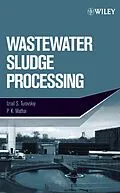Reap the benefits of sludge
The processing of wastewater sludge for use or disposal has been a
continuing challenge for municipal agencies. Yet, whensludge is
properly processed, the resulting nutrient-rich
product--biosolids--can be a valuable resource for agriculture and
other uses. Wastewater Sludge Processing brings together a wide
body of knowledge from the field to examine how to effectively
process sludge to reap its benefits, yet protect public
health.
Presented in a format useful as both a reference for practicing
environmental engineers and a textbook for graduatestudents, this
book discusses unit operations used for processing sludge and the
available methods for final disposition of the processed product.
Topics discussed include sludge quantities and characteristics,
thickening and dewatering, aerobicand anaerobic digestion, alkaline
stabilization, composting, thermal drying and incineration, energy
consumption, and the beneficial use of biosolids.
COMPREHENSIVE IN ITS COVERAGE, THE TEXT:
* Describes new and emerging technologies as well as international
methods
* Compares different types of sludge processing methods
* Explains both municipal and industrial treatment
technologies
Written by authors with decades of experience in the field,
Wastewater Sludge Processing is an invaluable tool for anyone
planning, designing, and implementing municipal wastewater sludge
management projects.
Autorentext
IZRAIL S. TUROVSKIY is a wastewater and biosolids consultant
in Jacksonville, Florida. He received a BS degree in civil
engineering from Civil Engineering Institute, St. Petersburg,
Russia; an MS degree in sanitary engineeringfrom Civil Engineering
Institute, Moscow, Russia; and a DSc degree in environmental
engineering from Municipal Academy,Moscow. He has more than fifty
years of experience in environmental engineering, including time as
head of the All-UnionResearch Institute of Water Supply, Sewage
Systems, and Hydrotechnical Structures in Moscow. Dr. Turovskiy has
patentsin Russia, France, Germany, Italy, Finland, and the United
States. He has also authored or coauthored more than 200technical
publications including eight books.
P. K. MATHAI is a senior project manager and Associate
Fellow in environmental engineering with Jacobs Civil, Inc. in St.
Louis, Missouri. He received a BS degree in civil engineering from
University of Kerala, India, and an MS degree in environmental
engineering from University of Dayton, Ohio. He has over thirty
years of wide-ranging experience in environmental engineering and
has been involved in the planning, design, and technical review of
over sixty wastewater treatment plants and sludge processing
facilities. He is a registered professional engineer in Missouri,
Illinois, Ohio, Kentucky, and Maryland.
Zusammenfassung
Reap the benefits of sludge
The processing of wastewater sludge for use or disposal has been a continuing challenge for municipal agencies. Yet, whensludge is properly processed, the resulting nutrient-rich product--biosolids--can be a valuable resource for agriculture and other uses. Wastewater Sludge Processing brings together a wide body of knowledge from the field to examine how to effectively process sludge to reap its benefits, yet protect public health.
Presented in a format useful as both a reference for practicing environmental engineers and a textbook for graduatestudents, this book discusses unit operations used for processing sludge and the available methods for final disposition of the processed product. Topics discussed include sludge quantities and characteristics, thickening and dewatering, aerobicand anaerobic digestion, alkaline stabilization, composting, thermal drying and incineration, energy consumption, and the beneficial use of biosolids.
COMPREHENSIVE IN ITS COVERAGE, THE TEXT:
* Describes new and emerging technologies as well as international methods
* Compares different types of sludge processing methods
* Explains both municipal and industrial treatment technologies
Written by authors with decades of experience in the field, Wastewater Sludge Processing is an invaluable tool for anyone planning, designing, and implementing municipal wastewater sludge management projects.
Inhalt
Preface xi
About the Authors xii
1 Introduction 1
1.1 Introduction, 2
1.2 40 CFR Part 503 Regulation, 2
1.2.1 General Provisions, 3
1.2.2 Land Application, 5
1.2.3 Surface Disposal, 11
1.2.4 Pathogen and Vector Attraction Reduction, 18
1.2.5 Incineration, 27
2 Sludge Quantities and Characteristics 30
2.1 Types of Sludge, 31
2.1.1 Primary Sludge, 32
2.1.2 Secondary Sludge, 32
2.1.3 Chemical Sludge, 32
2.1.4 Other Wastewater Residuals, 33
2.2 Sludge Quantity, 34
2.2.1 Primary Sludge, 34
2.2.2 Secondary Sludge, 36
2.2.3 Activated Sludge, 36
2.2.4 Attached Growth System Sludge, 42
2.2.5 Chemical Sludge, 43
2.3 Sludge Characteristics, 44
2.3.1 Primary Sludge, 44
2.3.2 Activated Sludge, 46
2.3.3 Physical and Biological Properties, 47
2.4 Mass Balance, 49
3 Thickening and Dewatering 60
3.1 Introduction, 61
3.2 Conditioning, 62
3.2.1 Factors Affecting Conditioning, 62
3.2.2 Chemical Conditioning, 64
3.2.3 Other Conditioning Methods, 77
3.3 Thickening, 81
3.3.1 Gravity Thickening, 81
3.3.2 Dissolved Air Flotation Thickening, 88
3.3.3 Centrifugal Thickening, 94
3.3.4 Gravity Belt Thickening, 99
3.3.5 Rotary Drum Thickening, 102
3.3.6 Miscellaneous Thickening Methods, 102
3.4 Dewatering, 106
3.4.1 Centrifugal Dewatering, 106
3.4.2 Belt Filter Press, 110
3.4.3 Pressure Filter Press, 116
3.4.4 Drying Beds, 121
3.4.5 Other Dewatering Methods, 127
4 Aerobic Digestion 136
4.1 Introduction, 137
4.1.1 Process Theory, 138
4.2 Conventional Aerobic Digestion, 141
4.2.1 Process Design Considerations, 144
4.2.2 System Design Considerations, 147
4.2.3 Operational Considerations, 155
4.3 Process Variations, 156
4.3.1 High-Purity Oxygen Digestion, 157
4.3.2 Low-Temperature Aerobic Digestion, 157
4.3.3 Dual Digestion, 157
4.3.4 Mesophilic Aerobic Digestion, 158
4.3.5 Autothermal Thermophilic Aerobic Digestion, 158
4.3.6 Technological Improvements, 164
5 Anaerobic Digestion 173
5.1 Introduction, 174
5.1.1 Advantages and Disadvantages, 174
5.1.2 Theory of Anaerobic Digestion, 175
5.2 Environmental Factors, 176
5.2.1 Solids and Hydraulic Retention Times, 177
5.2.2 Temperature, 177
5.2.3 pH and Alkalinity, 179
5.2.4 Toxic Materials, 180
5.3 Process Variations, 182
5.3.1 Low-Rate Digestion, 182
5.3.2 High-Rate Digestion, 183
5.3.3 Thermophilic Digestion, 185
5.3.4 Two-Stage Digestion, 185
5.3.5 Two-Phase Digestion, 186
5.4 Process Design, 188
5.4.1 Per Capita Basis, 188
5.4.2 Solids Loading, 189
5.4.3 Solids Retention Time, 189
5.4.4 Volatile Solids Reduction, 190
5.4.5 Gas Production, 190
5.5 System Component Design, 191
5.5.1 Tank Design, 191
5.5.2 Digester Covers, 193
5.5.3 Mixing, 193
5.5.4 Heating, 197
5.5.5 Gas Usage, 200
5.6 Operational Considerations, 205
5.6.1 Reactor Performance, 205
5.6.2 Odor Control, 207
5.6.3 Supernatant, 207
5.6.4 Struv…
